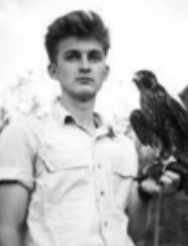- Date Of Birth: February 15, 1925
- Date Of Death: March 23, 2019
- Resting Place: Anchorage
- City: Anchorage
- State: Alaska
Vern Seifert, 94, passed on in Anchorage, Alaska, on Saturday, March 23, 2019. Born to German immigrants Richard and Martha Seifert in New York City on Feb. 15, 1925, Vern was fascinated by everything that flew. At age 4, he aspired to become a zeppelin captain. Raised in the Bronx, he hunted ducks along the East River with peregrine falcons he caught from the wild and trained. After World War II U.S. Navy service, he left NYC for Colorado, then moved to Alaska in 1959. He worked for Jonas Brothers taxidermists in Anchorage and was a bush pilot and guide. Traveling often to Point Hope, he developed a mutual affinity for the people there, who embraced him as a kindred spirit. Elders invited him on a whale hunt, and they strongly influenced Vern’s thinking and his art the rest of his life.
Vern was a painter, sculptor and woodcarver; his totem poles still stand around Anchorage – at the Arctic Roadrunner, the Coast International Inn and at 4th Avenue and G Street. His life-sized goshawk chasing a mallard took top honors at his first-ever woodcarving competition. Vern’s enormous fiberglass rhinoceros beetle continues to delight visitors to the May Natural History Museum near Colorado Springs. He cast an entire beluga whale in plaster of Paris and molded life-sized fiberglass replicas, which remain in museums and private collections. Vern’s organic understanding of wildlife led to some of the first-ever breeding of large falcons in captivity. He understood people, too; dead-on accuracy and unflinching honesty delighted and infuriated his friends. Vern attracted children, whom he lovingly quizzed, amused, instructed and occasionally terrified. Vern’s life-long close friend and schoolteacher Debbie dubbed him “Birdman,” and neighbor kids called him “Crazy Wolf.” The nicknames stuck, and were used affectionately for years. Vern looked to nature for inspiration for his unconventional aircraft designs. He flew a Piper J-3 modified to mimic a gyrfalcon, complete with pivoting wingtips. In the early 1960s, he improved the performance of his Taylorcraft L-2 by adding “knuckles” – like tubercles on humpback whale flippers – to the leading edges of the wings. His advances were recognized decades later by academics and engineers. Vern flew the L-2 as recently as last year. Insatiably curious, Vern fascinated, inspired and sometimes frustrated all who entered his orbit. Fiercely independent, he was unaffected by accolades or criticism.
Vern rode his bike or walked every day into his 90s. He lived independently until two weeks before his death, in a home built from materials salvaged after the 1964 Earthquake. Vern was preceded in death by his parents and younger brother, and is survived by his other brother in New York; two nieces; five nephews; and three grandnieces; cousins in Germany; his extended “Alaska Family”; and many friends, colleagues and admirers. On the phone with an old falconer friend on what proved to be his final birthday, Vern said: “We’ve had a good ride, haven’t we? What a wonderful planet we were put on.” The planet will not see another like him.
